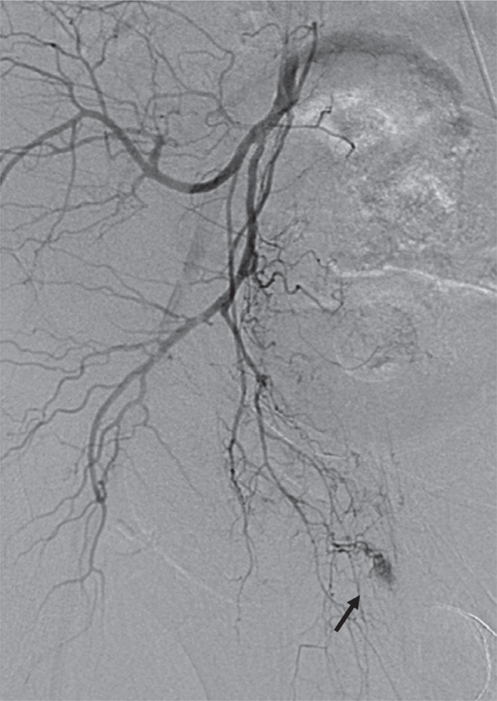Korean Circ J.
2016 Mar;46(2):256-259. 10.4070/kcj.2016.46.2.256.
Spontaneous Bleeding from Internal Pudendal Artery associated with Abciximab after Primary Percutaneous Coronary Intervention: Successful Treatment with Percutaneous Gel-Foam Embolization
- Affiliations
-
- 1Department of Internal Medicine, Dongguk University Ilsan Hospital, Goyang, Korea. harrison72@dumc.or.kr
- 2Department of Radiology, Dongguk University Ilsan Hospital, Goyang, Korea.
- 3Department of Medicine, Graduate School, Dongguk University, Seoul, Korea.
- KMID: 2344478
- DOI: http://doi.org/10.4070/kcj.2016.46.2.256
Abstract
- We describe a case of spontaneous bleeding from a branch of the right internal pudendal artery that resulted in massive scrotal swelling in a patient who had underwent primary percutaneous coronary intervention with the use of abciximab concurrent with conventional anticoagulation and dual antiplatelet therapies for the treatment of acute ST-segment elevation myocardial infarction. This unusual complication was promptly identified by percutaneous peripheral arteriography and successfully treated with gel-foam embolization.
MeSH Terms
Figure
Reference
-
1. De Luca G, Suryapranata H, Stone GW, et al. Abciximab as adjunctive therapy to reperfusion in acute ST-segment elevation myocardial infarction: a meta-analysis of randomized trials. JAMA. 2005; 293:1759–1765.2. Cote AV, Berger PB, Holmes DR Jr, Scott CG, Bell MR. Hemorrhagic and vascular complications after percutaneous coronary intervention with adjunctive abciximab. Mayo Clin Proc. 2001; 76:890–896.3. Khanlou H, Eiger G, Yazdanfar S. Abciximab and alveolar hemorrhage. N Engl J Med. 1998; 339:1861–1863.4. Cherukuri M, Pershad A. Late spontaneous epigastric arterial bleeding associated with abciximab: successful percutaneous treatment with coil gel-foam embolization. J Invasive Cardiol. 2002; 14:692–693.5. Dorval JF, Soulez G, Berry C, Bonan R. Management of a spontaneous renal capsule hematoma following cardiac catheterization involving use of a platelet glycoprotein IIb/IIIa inhibitor: a case report. Catheter Cardiovasc Interv. 2007; 69:994–997.6. American College of Emergency Physicians. Society for Cardiovascular Angiography and Interventions. O'Gara PT, et al. 2013 ACCF/AHA guideline for the management of ST-elevation myocardial infarction: a report of the American College of Cardiology Foundation/American Heart Association Task Force on Practice Guidelines. J Am Coll Cardiol. 2013; 61:e78–e140.7. Dziewierz A, Rakowski T, Dudek D. Abciximab in the management of acute myocardial infarction with ST-segment elevation: evidence-based treatment, current clinical use, and future perspectives. Ther Clin Risk Manag. 2014; 10:567–576.8. Iqbal Z, Cohen M, Pollack C, et al. Safety and efficacy of adjuvant glycoprotein IIb/IIIa inhibitors during primary percutaneous coronary intervention performed from the radial approach for acute ST segment elevation myocardial infarction. Am J Cardiol. 2013; 111:1727–1733.9. Parodi G, De Luca G, Moschi G, et al. Safety of immediate reversal of anticoagulation by protamine to reduce bleeding complications after infarct artery stenting for acute myocardial infarction and adjunctive abciximab therapy. J Thromb Thrombolysis. 2010; 30:446–451.
- Full Text Links
- Actions
-
Cited
- CITED
-
- Close
- Share
- Similar articles
-
- Acute Profound Thrombocytopenia after Using Abciximab for No-Reflow during Primary Percutaneous Coronary Intervention for ST-Segment Elevation Myocardial Infarction
- Recent Advances in Percutaneous Coronary Intervention in Coronary Artery Disease
- No-Reflow Phoenomenon by Intracoronary Thrombus in Acute Myocardial Infarction
- Spontaneous coronary artery dissection by intravascular ultrasound in a patient with myocardial infarction
- A Case of a Successful Percutaneous Coronary Intervention Using Percusurge(r) System in a Massive Intracoronary Thrombi Patient




